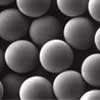Non-Functionalized Polystyrene

We offer uniform polystyrene latex microspheres that may be used as-is for standards or markers, or coated with proteins via adsorption for use in diagnostic tests and assays. Our spheres are synthesized via emulsion polymerization, and are available in diameters from ~20nm-90µm, with typical size CVs of 5-10%. For applications that require highly stringent CVs (e.g. 2-5%), call for product availability. Most products are supplied as a 10% solids suspension (100mg/mL) in de-ionized water with surfactant and sodium azide.
PS and PS/DVB
Many proteins may be easily and stably absorbed to hydrophobic, non-functionalized microspheres. Divinylbenzene (DVB) confers additional solvent and heat resistance to our crosslinked spheres. Unless noted otherwise, PS and PS/DVB microspheres are available as ~10% solids (w/w) aqueous suspensions in these standard amounts: 0.5g, 1.0g, 1.5g, and 5.0g.
TechNote 204, Adsorption to Microspheres
PDS 732, Polystyrene Microspheres
| Catalog Number | Nominal Diameter |
Specification Range |
|---|---|---|
| PS02001 | 0.025µm | 0.015 - 0.035µm |
| PS02002 | 0.050µm | 0.040 - 0.060µm |
| PS02003 | 0.075µm | 0.065 - 0.085µm |
| PS02004 | 0.100µm | 0.090 - 0.110µm |
| PS02005 | 0.125µm | 0.115 - 0.135µm |
| PS02006 | 0.150µm | 0.140 - 0.160µm |
| PS02007 | 0.175µm | 0.165 - 0.185µm |
| PS02008 | 0.200µm | 0.190 - 0.210µm |
| PS02009 | 0.300µm | 0.270 - 0.330µm |
| PS02010 | 0.400µm | 0.370 - 0.430µm |
| PS03001 | 0.500µm | 0.470 - 0.530µm |
| PS03002 | 0.600µm | 0.570 - 0.630µm |
| PS03003 | 0.700µm | 0.670 - 0.730µm |
| PS03004 | 0.800µm | 0.770 - 0.830µm |
| PS03005 | 0.900µm | 0.870 - 0.930µm |
| PS04001 | 1.00µm | 0.95 - 1.05µm |
| PS05001 | 2.00µm | 1.80 - 2.20µm |
| PS05002 | 3.00µm | 2.80 - 3.20µm |
| PS05003 | 4.00µm | 3.80 - 4.20µm |
| PS06001 | 5.00µm | 4.80 - 5.20µm |
| PS06002 | 5.50µm | 5.30 - 5.70µm |
| PS06003 | 6.00µm | 5.80 - 6.20µm |
| PS06004 | 7.00µm | 6.80 - 7.20µm |
| PS06005 | 7.50µm | 7.30 - 7.70µm |
| PS07001 | 10.00µm | 9.50 - 10.50µm |
| PS07002 | 15.00µm | 14.50 - 15.50µm |
| PS07003 | 20.00µm | 19.00 - 21.00µm |
| PS08001 | >25.µm | >25.00µm (Inquire) |
References
Joubert, M, Hokom, M, Eakin, C, Zhou, L, Deshpande, M, Baker,M, …Jawa, J (2012) Highly Aggregated Antibody Therapeutics Can Enhance the in Vitro Innate and Late-stage T-cell Immune Responses J Biol Chem 287:25266
